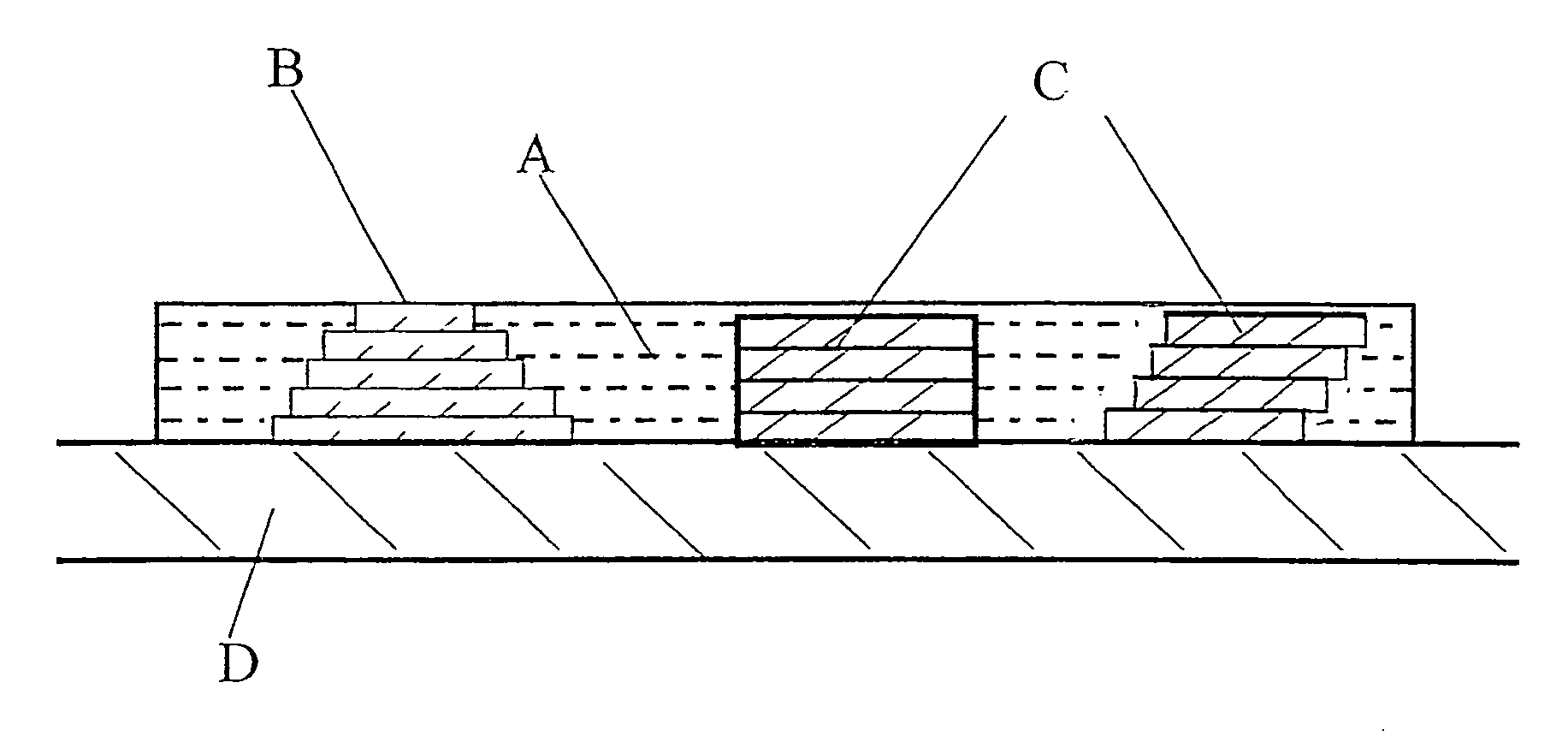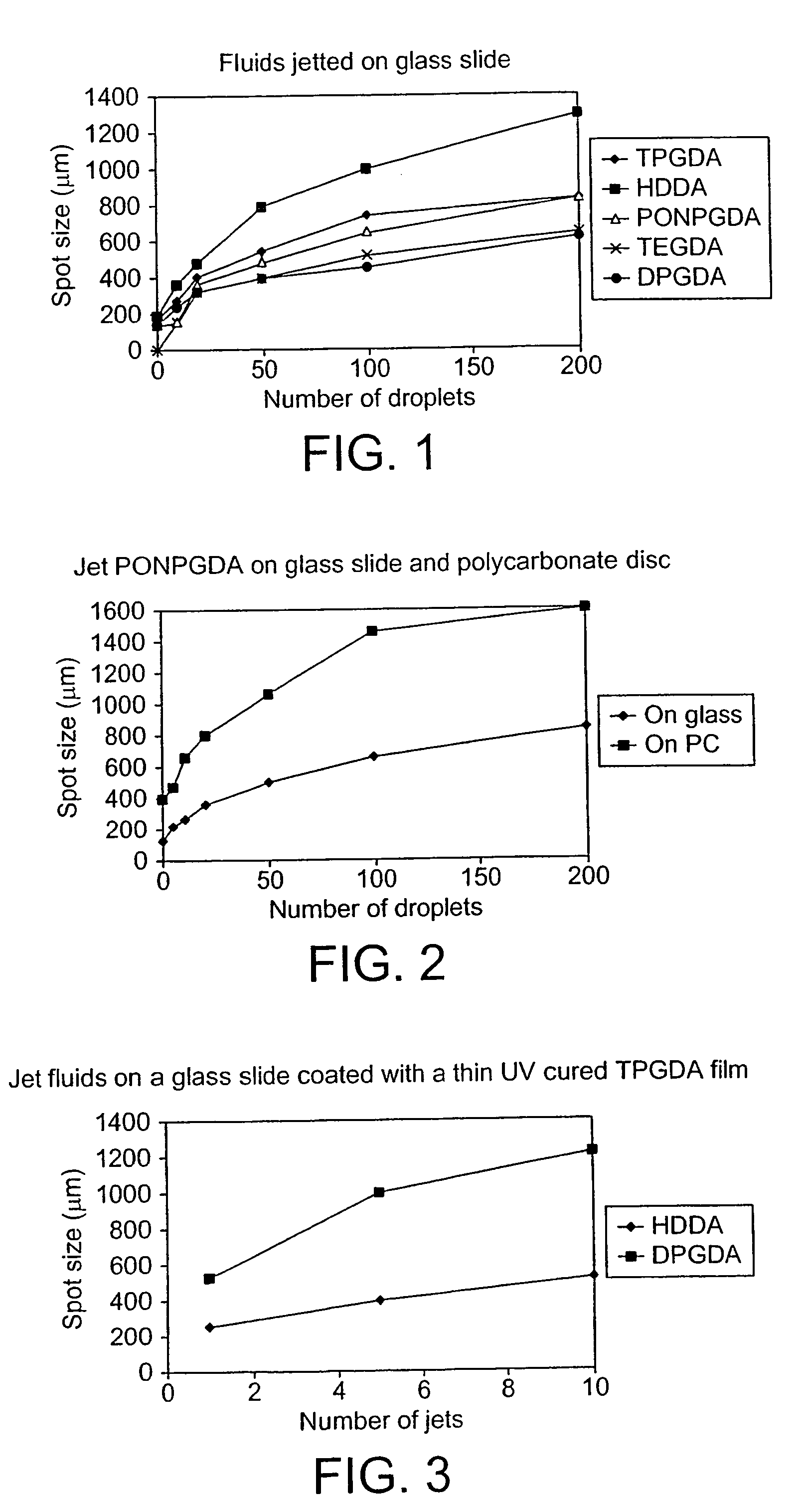Production of composites articles composed of thin layers
a technology of composite articles and thin layers, applied in the direction of additive manufacturing processes, liquid/solution decomposition chemical coatings, superimposed coating processes, etc., can solve the problems of difficult variation of this method, limited materials available, and difficult to form a substantially uniform thickness layer. , to achieve the effect of reducing the viscosity of compositions
- Summary
- Abstract
- Description
- Claims
- Application Information
AI Technical Summary
Benefits of technology
Problems solved by technology
Method used
Image
Examples
example 1
[0087]A Jetlab ink jet printer (obtainable from Microfab Technologies Ltd, Texas, USA) was used for jetting droplets onto a substrate. This equipment can precisely control the volume of jet droplet and printing pattern. The printer incorporates a piezo printhead. the temperature of which can be controlled, which enables the jetting of fluids at elevated temperatures that have an excessively high viscosity at room temperature.
[0088]The jet performance is dependent on physical properties of fluids such as viscosity and surface tension. Therefore, investigation of jet performances as a function of viscosity and surface tension was undertaken to find appropriate jet conditions for various fluids. A number of low-viscosity acyl ate monomers were selected due to their fast UV cure as well as good physical properties and jetted onto a substrate at room temperature.
[0089]
TABLE 1SurfaceTensionViscosityDwellFluidsSupplier / Code(mN / m)(MPas)Voltage (V)TPGDAGenomer 123034*1730HDDAGenomer 122335*6...
example 2
[0094]A number of droplets were directed at the same target area on a substrate at room temperature and the extent of spread of the resulting spot was measured on a video screen connected a digital (CCD) camera.
[0095]Each droplet had an in-flight diameter of approximately 50 μm. The number of droplets deposited on the spot was varied and the size of the spot (after spreading) was plotted against the number of droplets used to form the spot. The results for the jetting of various monomers onto a glass substrate are shown in FIG. 1.
[0096]As can be seen, the spot size increases with the number of droplets but not, however, as a linear relationship. The degree of increase is reduced as the number of droplets increases.
[0097]PONPGDA droplets were jetted onto the same target on a glass slide and a polycarbonate disc. The results are shown in FIG. 2.
[0098]As can be seen, the spot size of jet fluids on the polycarbonate substrate is much larger than that on the glass slide, because PONPGDA ...
example 3
[0099]Three fluids: PONPGDA, DPGDA and HDDA were jetted at room temperature onto the same target area of a glass slide coated with a thin film of UV-cured TPGDA. Of the three fluids, the surface tension of PONPGDA is lowest and is lower than that of the substrate TPGDA film. The spot size of PONPGDA is very large and a ring is formed, making it difficult to form a continuous film. The results from the other two fluids are shown in FIG. 3.
[0100]Thus it can be seen:
[0101]Jetting a fluid (PONPGDA) whose surface tension is lower than that of substrate leads to poor film formation.
[0102]Fluid (HDDA) with higher surface tension than the substrate-forms a smaller spot size, which is not favourable to make very thin films.
[0103]Large spot size and good film formation is obtained from DPGDA which possesses approximately the same value of surface tension as the substrate (TPGDA).
PUM
| Property | Measurement | Unit |
|---|---|---|
| thickness | aaaaa | aaaaa |
| thickness | aaaaa | aaaaa |
| thickness | aaaaa | aaaaa |
Abstract
Description
Claims
Application Information
 Login to View More
Login to View More - R&D
- Intellectual Property
- Life Sciences
- Materials
- Tech Scout
- Unparalleled Data Quality
- Higher Quality Content
- 60% Fewer Hallucinations
Browse by: Latest US Patents, China's latest patents, Technical Efficacy Thesaurus, Application Domain, Technology Topic, Popular Technical Reports.
© 2025 PatSnap. All rights reserved.Legal|Privacy policy|Modern Slavery Act Transparency Statement|Sitemap|About US| Contact US: help@patsnap.com



